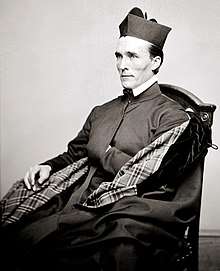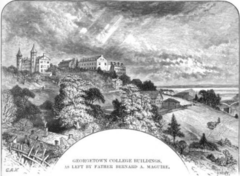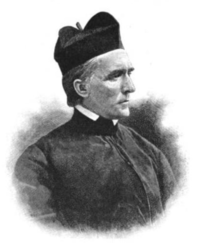Bernard A. Maguire
Bernard A. Maguire (February 11, 1818 – April 26, 1886) was an Irish-American Catholic priest and Jesuit. Born in Ireland, he emigrated to the United States at the age of six, where his family settled in Maryland. He attended Saint John's College in Frederick, Maryland, and then entered the Society of Jesus in 1837. He continued his studies at Georgetown University, where he also taught and was prefect, until his ordination to the priesthood in 1851.
Bernard A. Maguire | |
|---|---|
 | |
| 22nd & 24th President of Georgetown University | |
| In office 1866–1870 | |
| Preceded by | John Early |
| Succeeded by | John Early |
| In office 1853–1858 | |
| Preceded by | Charles H. Stonestreet |
| Succeeded by | John Early |
| Personal details | |
| Born | February 11, 1818 Edgeworthstown, County Longford, Ireland |
| Died | April 26, 1886 (aged 68) Philadelphia, Pennsylvania, United States |
| Resting place | Jesuit Community Cemetery |
| Alma mater | |
| Orders | |
| Ordination | September 27, 1851 by John McGill |
The following year, Maguire was appointed president of Georgetown University. His tenure was regarded as successful, with new buildings being erected, the number of students increased, and the preparatory division being partially separated from Georgetown College. Upon the end of his presidency in 1858, he engaged in pastoral and missionary work in Washington, D.C., Maryland, and Virginia, and developed a reputation as a skilled preacher. Maguire again became president of Georgetown in 1866, in the aftermath of the American Civil War, which had devastated the university. He worked to repair the campus and return enrollment to a sustainable level. The long-planned Georgetown Law School was also established at the end of his presidency. His term came to an end in 1870, and he returned to missionary work, traveling throughout the country. He died in Philadelphia in 1886.
Early life
Bernard A. Maguire was born on February 11, 1818, in the town of Edgeworthstown in County Longford, in the United Kingdom of Great Britain and Ireland (in modern-day Ireland) He emigrated to the United States at the age of six with his parents. They took up residence near Frederick, Maryland, where his father worked on the construction of the Chesapeake and Ohio Canal. A Catholic priest, John McElroy, would visit families working on the canal project, including the Maguire family. He thought Bernard would be suitable for the priesthood and ensured that he received an education.[1] As an adult, Maguire would be described as "tall, slender, and black-haired."[2]
Education
McElroy enrolled Maguire in Saint John's College in Frederick, a Jesuit school of which McElroy was president. Among Maguire's professors was Virgil Horace Barber. In school, Maguire and his classmate, Enoch Louis Lowe, were continually at the top of their class, and they participated in oratory declamations together.[3]
On September 20, 1837, Maguire entered the Society of Jesus,[3] and proceeded to the Jesuit novitiate in Frederick,[2] where he was supervised by Francis Dzierozynski. He then began his studies at Georgetown University, where he studied rhetoric from 1839 to 1840 and philosophy from 1840 to 1841.[3] While studying philosophy, he also served as prefect of the university. His studies at Georgetown were paused from 1842 to 1843, during which time he was the prefect and overseer of the library and museum at Saint John's College. The following academic year, Maguire returned to Georgetown, where he taught grammar, mathematics, and French; for the academic year of 1845 and 1846, he ceased teaching grammar so that he could again be the prefect.[4]
In 1846, Maguire began his theological studies for the priesthood. His studies were paused during the academic year of 1849 and 1850, which he spent catechizing the students at Georgetown. He remained as prefect, and during this time, there was an uprising among the students, which resulted in the dismissal of seventy from the university.[4] Maguire negotiated a settlement, in which the expelled students would be allowed back in exchange for a formal apology. Upon the resolution of the rebellion, the Maguire replaced Burchard Villger as first prefect.[5] On September 27, 1851, he was ordained a priest by John McGill, the Bishop of Richmond.[4]
Georgetown University

First presidency
During his tertianship from 1851 to 1852, which was supervised by Felix Cicaterri.[4] Maguire was elected president of Georgetown University by the board of directors in December 1852 to succeed Charles H. Stonestreet.[2] His election was made official with his appointment by the provincial superior and confirmation by the Jesuit Superior General. He assumed the position on January 25, 1853. As president, Maguire was liked by the students, but had a reputation for being stern. This was evidenced by the fact that another student uprising broke out during his tenure.[4] The students were displeased with the prefect's imposition of discipline and Maguire's declining to overrule the prefect. Students began throwing stones and inkwells, breaking windows.[6] The rebellion was quickly quashed after a lecture by Maguire to the students at breakfast the following morning.[4] Six students were expelled as a result.[7]
Maguire promoted dramatic and literary societies among the students.[8] In April of 1853, the university was visited by the Catholic intellectual Orestes Brownson,[9] and the commencement of 1854 was attended by Franklin Pierce, the President of the United States.[10] A fire broke out on December 6, 1854, destroying the shed where the tailor and shoemaker worked. The university's vice president noticed the fire during the night, and awoke others who prevented it from spreading to the other buildings.[11]
Despite the construction of new buildings, a significant increase in the number of students left Georgetown pressed for physical accommodations. Therefore, Maguire sought to erect another building, but these plans were rendered untenable by the Panic of 1857.[8] The economic crisis also made it difficult for the university to hire a sufficient number of faculty.[12] Overall, Maguire was regarded as a successful president.[8] On October 5, 1858, his term came to an end and was he succeeded by John Early.[13]
Separation of the preparatory division

A number of improvements were made to the university's facilities during Maguire's presidency. The preparatory division (later becoming Georgetown Preparatory School) was separated from Georgetown College in 1851, both to reduce any negative influence the older students had on the younger ones and because the intermixing of ages dissuaded some older students from attending Georgetown's higher education division. The preparatory division was further segregated with the organization of separate housing for the younger students in 1852 and the institution of a separate academic calendar in 1856.[2] This division did, indeed, result in a significant increase in the number of college-aged students.[2]
Construction on a separate building for the preparatory division began in June 1854. The five-story building connected the two buildings to its east and west, and contained a playroom, public hall, classrooms, a study hall, and dormitory space.[14] More modest than was originally envisioned several years prior, the Preparatory Building cost $20,000 and was complete by the commencement of 1855. It was outfitted with new gas lamps, rather than oil lamps. The Preparatory Building later was renamed Maguire Hall.[8]
Second presidency
Maguire again became president of Georgetown University on January 1, 1866,[15] replacing Early.[16] He took office in the aftermath of the American Civil War. Enrollment at the university had suffered greatly during the war, and few students remained when Maguire returned to the presidency.[17] By the end of his term, the number of students had begun to rebound and the damaged buildings were repaired and improved.[18] Discussions about creating a law school began during the term of Maguire's predecessor, but were suspended due to the war. During Maguire's term, at the suggestion of a future university president Patrick F. Healy,[19] these discussions resumed and became more concrete by 1869. Eventually, the university's board of directors approved the establishment of Georgetown Law School in March 1870. Maguire desired the law school to be more integrated with the rest of the university, unlike the medical school, which operated largely autonomously. He selected the first six faculty members, and announced the creation of the new school at the university commencement,[20] on June 30 of that year.[21] The law school's first classes began in October.[22]
President Ulysses S. Grant attended the commencement of 1869 and conferred the degrees.[23] Maguire's health had begun to deteriorate by 1869, and the new provincial superior, Joseph Keller, began considering who to appoint as his successor, in consultation with the Jesuit superiors in Rome.[24] Maguire's tenure came to an end in July 1870,[17] and John Early was again named as his successor.[25]
Pastoral work

After his first presidency of Georgetown, Maguire was sent to St. Joseph's Church in Baltimore in 1858, where he engaged in pastoral work for the first time. There, he garnered a reputation as a skilled orator. In 1859, he was transferred to St. Aloysius Church in Washington, D.C., where his renown as a preacher grew, and his sermons caused a substantial number of Protestants to convert to Catholicism.[13] Maguire left St. Aloysius at the end of 1864 for Frederick, Maryland, from where he worked as a missionary in Maryland and Virginia. This missionary work also resulted in conversions to Catholicism.[17] One such convert, who had heard Maguire preach in Virginia, was Thomas H. Stack, who later became a Jesuit and the president of Boston College.[26]
Later years
Following his second presidency of the university, Maguire returned to St. Aloysius Church as the pastor. He preached regularly, until he retired from the position in May 1875.[17] He returned to missionary work, preaching in Canada and San Francisco.[27] He resigned these duties when health prevented him from continuing in 1884.[17]
In April 1886, Maguire led a retreat on Passion Sunday at Old St. Joseph's Church in Philadelphia, Pennsylvania, after having just finished leading a triduum at the Cathedral of the Assumption in Baltimore. On the third day of the retreat, he fell ill and was taken to St. Joseph's Hospital, where he died on April 26, 1886.[28] His requiem mass was held at St. Aloysius Church, and he was buried at the Jesuit Community Cemetery at Georgetown University.[29]
References
Citations
- J. A. M. 1887, p. 3
- Curran 1993, p. 158
- J. A. M. 1887, p. 4
- J. A. M. 1887, p. 5
- Curran 1993, p. 185
- Shea 1891, p. 178
- Shea 1891, p. 179
- Curran 1993, p. 159
- Shea 1891, p. 181
- Shea 1891, p. 183
- Shea 1891, p. 184
- Curran 1993, p. 138
- J. A. M. 1887, p. 6
- Curran 1993, pp. 158–159
- Shea 1891, p. 214
- Curran 1993, p. 404
- J. A. M. 1887, p. 7
- Summerfield & Devine 1998, p. 175
- Georgetown Law Journal 1920, pp. 15, 66
- Curran 1993, p. 272
- Georgetown Law Journal 1920, p. 1
- Georgetown Law Journal 1920, p. 12
- Shea 1891, p. 224
- Curran 1993, p. 280
- Curran 1993, p. 254
- Curran 1993, p. 266
- J. A. M. 1887, p. 8
- J. A. M. 1887, p. 9
- Shea 1891, p. 234
Sources
- Curran, Robert Emmett (1993). The Bicentennial History of Georgetown University: From Academy to University, 1789–1889. Washington, D.C.: Georgetown University Press. ISBN 0878404856. Archived from the original on February 2, 2020. Retrieved February 2, 2020 – via Google Books.CS1 maint: ref=harv (link)
- "Foreword". Georgetown Law Journal. 9 (2): 1–2. December 1920. Archived from the original on November 28, 2018. Retrieved November 28, 2018 – via Google Books.
- J. A. M. (March 1, 1887). "Father Bernard A. Maguire: A Sketch". Woodstock Letters. XVI (1): 3–10. Archived from the original on January 7, 2020. Retrieved November 30, 2018 – via Jesuit Online Library.CS1 maint: ref=harv (link)
- Shea, John Gilmary (1891). Memorial of the First Century of Georgetown College, D. C.: Comprising a History of Georgetown University. 3. New York: P. F. Collier. pp. 178–196, 214–234. OCLC 612832863. Archived from the original on November 28, 2018. Retrieved November 28, 2018 – via Google Books.CS1 maint: ref=harv (link)
- Summerfield, Carol; Devine, Mary Elizabeth, eds. (1998). International Dictionary of University Histories. Chicago: Fitzroy Dearborn Publishers. p. 175. ISBN 9781884964237. Archived from the original on November 26, 2018. Retrieved November 26, 2018 – via Google Books.CS1 maint: ref=harv (link)
External links
| Wikimedia Commons has media related to Bernard A. Maguire. |
| Academic offices | ||
|---|---|---|
| Preceded by Charles H. Stonestreet |
22nd President of Georgetown University 1853–1858 |
Succeeded by John Early |
| Preceded by John Early |
24th President of Georgetown University 1866–1870 |
Succeeded by John Early |